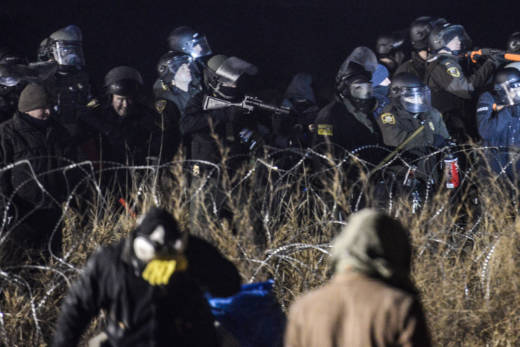Sisk, who has been reporting on the protest for NPR for months, says the clash on Sunday night saw 400 protesters and police facing off over a bridge that had been closed by authorities, blocking access to the pipeline construction site:
“As protesters took to the bridge, police deployed tear gas and sponge bullets. They also sprayed water on demonstrators while the temperature was below freezing, sparking concerns about hypothermia. Protest leaders report numerous injuries requiring hospitalization.
“Linda Black Elk is a medic at the protesters’ camp. ‘It seems like with every action with every conflict that takes place they escalate their violent tactics by using some new type of weaponry,’ [she says].”
“Rob Keller with the Morton County Sheriff’s Department says protesters refused to obey police orders, and some pelted officers with rocks. He defends police crowd control methods:
” ‘Had they not been utilized, that line would probably have been overrun and we’d have a worse situation than we have now.’ “
Protesters say police threw a concussion grenade that hit 21-year-old Wilansky and caused her injury. Wilansky’s father told The Associated Press that there were multiple witnesses — “and my daughter, who was completely conscious, said they threw a grenade right at her.”
Police say they did not use any equipment that could have caused Wilansky’s injury. A statement from the sheriff’s office said propane tanks were recovered at the site and suggested demonstrators might have been intentionally puncturing them to rig them to explode, the AP reports.
No one was arrested for making explosives, a sheriff’s spokeswoman told the L.A. Times.
The protests at Standing Rock are “likely to continue,” Sisk reports, with protesters vowing to stay until the construction of the pipeline is stopped.
As the Two-Way has reported, the $3.8 billion pipeline would cross the Missouri River just upstream from the Standing Rock Sioux Reservation. The tribe is opposed because it says the pipeline would interrupt sacred lands and could contaminate drinking water if it ruptures.
The U.S. Army Corps of Engineers said last week that it needs more time to evaluate whether the pipeline should be built on its planned route.
As NPR’s Jeff Brady reported earlier this week, the protest has attracted activists from around the world.
“Most of the long-term protesters are Native Americans. Others cycle through, some staying for weeks and others just a few days,” Brady reported. He says people are joining the cause for ideological, spiritual and personal reasons.
One demonstrator, Cameron Lisondra of the Mississippi Band of Choctaw Indians, said it meant a lot to be able to connect with other Native Americans.
“Lisondra says he doubts this large a gathering of indigenous people from around the world will happen again in his lifetime,” Brady says. “He predicts whatever the outcome, this protest and the thousands who’ve played a role will be talked about for generations to come.”
Copyright 2016 NPR. To see more, visit www.npr.org.

